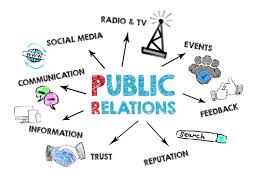Unlocking Success: The Impact of Global PR Strategies on International Brands
The Power of Global Public Relations
In today’s interconnected world, the importance of global public relations (PR) cannot be overstated. With businesses operating on a global scale and audiences spanning across different countries and cultures, effective PR strategies are essential to building a strong brand presence and reputation worldwide.
Global PR involves managing communication and relationships with stakeholders across various regions and demographics. It requires a deep understanding of cultural nuances, local media landscapes, and international trends to craft messages that resonate with diverse audiences.
One of the key benefits of global PR is its ability to create a cohesive brand image that transcends borders. By maintaining consistent messaging and branding across different markets, companies can establish trust and credibility with customers worldwide.
Global PR also plays a crucial role in crisis management on an international scale. In today’s digital age, news travels fast, and a crisis in one part of the world can quickly impact a company’s reputation globally. Effective global PR strategies help companies navigate challenging situations, mitigate damage, and protect their brand integrity.
Furthermore, global PR opens up opportunities for businesses to expand into new markets and reach untapped audiences. By leveraging local insights and partnerships, companies can tailor their messaging to resonate with specific cultural preferences and consumer behaviours.
Overall, global PR is an indispensable tool for businesses looking to thrive in the competitive global marketplace. It enables companies to build meaningful connections with audiences around the world, drive brand awareness, and ultimately achieve sustainable growth on an international scale.
Top 8 Frequently Asked Questions About Global Public Relations (PR)
- What is global public relations (PR) and why is it important?
- How does global PR differ from local or national PR strategies?
- What are the key challenges of implementing global PR campaigns?
- How can cultural differences impact global PR efforts?
- What role does social media play in global PR?
- How can companies measure the success of their global PR initiatives?
- What are the best practices for crisis management in global PR?
- How can businesses ensure consistency in messaging across different regions in global PR?
What is global public relations (PR) and why is it important?
Global public relations (PR) encompasses the strategic management of communication and relationships with diverse stakeholders across international markets. It involves crafting messages that resonate with various cultures, understanding local media landscapes, and maintaining a consistent brand image worldwide. Global PR is crucial for businesses operating on a global scale as it helps build trust, credibility, and brand reputation across borders. By implementing effective global PR strategies, companies can navigate cultural differences, manage crises on an international level, expand into new markets, and ultimately drive sustainable growth in the competitive global marketplace.
How does global PR differ from local or national PR strategies?
Global PR differs from local or national PR strategies in several key ways. While local or national PR strategies focus on specific markets and audiences within a particular region or country, global PR takes a broader approach by considering the diverse cultural, linguistic, and regulatory landscapes of multiple countries. Global PR requires a deep understanding of international markets, communication channels, and consumer behaviours to create cohesive messaging that resonates with a global audience. Additionally, global PR often involves navigating complex geopolitical issues, language barriers, and varying media landscapes to ensure consistent brand representation across different regions. By adopting a more holistic and cross-cultural perspective, global PR strategies aim to establish a unified brand identity that transcends borders and effectively engages with audiences on a worldwide scale.
What are the key challenges of implementing global PR campaigns?
Implementing global PR campaigns presents several key challenges that organisations must navigate to ensure success. One major challenge is the need to tailor messaging and strategies to resonate with diverse cultural norms, languages, and media landscapes across different regions. Maintaining consistency in brand messaging while accommodating local nuances requires a deep understanding of each market and audience. Another challenge is managing communication effectively in real-time across multiple time zones, ensuring timely responses to global events and crises. Additionally, coordinating with local PR teams, agencies, and stakeholders can be complex, requiring strong communication and collaboration skills to align efforts towards common goals. Overcoming these challenges demands strategic planning, cultural sensitivity, flexibility, and a keen awareness of global trends in order to create impactful PR campaigns that resonate on a global scale.
How can cultural differences impact global PR efforts?
Cultural differences play a significant role in shaping the success of global PR efforts. Understanding and navigating these differences are crucial for effective communication strategies across diverse markets. Cultural nuances such as language, values, customs, and traditions can influence how messages are interpreted and received by audiences worldwide. Failure to consider these cultural differences can lead to misunderstandings, misinterpretations, and even reputational damage for businesses operating on a global scale. Therefore, it is essential for PR professionals to conduct thorough research, adapt messaging accordingly, and cultivate cross-cultural sensitivity to ensure that their global PR efforts resonate positively with diverse audiences and enhance brand reputation across borders.
What role does social media play in global PR?
In the realm of global public relations, social media plays a pivotal role in enhancing communication strategies and reaching diverse audiences worldwide. Social media platforms serve as powerful tools for engaging with stakeholders across different regions, facilitating real-time interactions, and amplifying brand messaging on a global scale. Through targeted social media campaigns, companies can tailor their content to resonate with specific cultural preferences and local trends, fostering meaningful connections with international audiences. Furthermore, social media enables PR professionals to monitor conversations, gather feedback, and respond swiftly to emerging issues, enhancing crisis management efforts and maintaining brand reputation across borders. Embracing social media as part of a comprehensive global PR strategy is essential in today’s interconnected world to drive brand awareness, build credibility, and foster long-lasting relationships with a diverse range of stakeholders.
How can companies measure the success of their global PR initiatives?
Measuring the success of global PR initiatives is crucial for companies to evaluate the impact of their communication efforts on a global scale. Companies can assess the effectiveness of their global PR strategies by analysing key performance indicators such as media coverage, brand sentiment, audience engagement, and website traffic. Tracking metrics like reach, impressions, social media interactions, and conversion rates can provide valuable insights into the reach and resonance of PR campaigns across different regions. Additionally, conducting surveys, focus groups, and sentiment analysis in various markets can help companies gauge public perception and reputation. By establishing clear objectives and using a combination of qualitative and quantitative data analysis, companies can gain a comprehensive understanding of the success of their global PR initiatives and make informed decisions to enhance future strategies.
What are the best practices for crisis management in global PR?
When it comes to crisis management in global public relations, implementing best practices is crucial to effectively navigate challenging situations on an international scale. Key strategies include establishing a comprehensive crisis communication plan that outlines roles, responsibilities, and communication protocols across different regions. It is essential to maintain transparency, authenticity, and timeliness in addressing crises to build trust with stakeholders worldwide. Additionally, conducting regular risk assessments, monitoring global media trends, and having a designated global PR team equipped to respond swiftly and strategically are vital components of successful crisis management in global PR.
How can businesses ensure consistency in messaging across different regions in global PR?
Ensuring consistency in messaging across different regions in global PR is a critical aspect for businesses aiming to maintain a strong and unified brand image worldwide. To achieve this, businesses can implement several key strategies. Firstly, developing a comprehensive global PR strategy that outlines core messaging, brand values, and communication guidelines can serve as a reference point for all regional teams. Regular communication and training sessions with local PR teams can help align messaging and ensure a shared understanding of the brand’s voice and positioning. Utilising centralised tools and platforms for content creation and distribution can also streamline the process of disseminating consistent messages across various regions. Additionally, establishing clear approval processes and checkpoints for all PR materials can help maintain message coherence while allowing for necessary adaptations to suit local cultural sensitivities or market nuances. By prioritising collaboration, transparency, and adaptability, businesses can successfully uphold message consistency in their global PR efforts.












